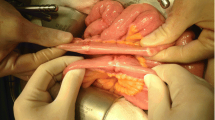Abstract
In contemporary surgical series, the incidence of multifocal tumours (MFT) in small bowel neuroendrocrine tumours (SBNET) is as high as 50%. Familial forms of SBNET appear to have an even higher rate of MFTs in the range of 80%. Multifocal disease poses several challenges and questions for the operating surgeon, including the cause of the disease whether it is local metastases or a genetic field defect, the extent of the resection, and the prognosis. The etiology of these multiple tumours appears to be multifactorial and may represent localized metastases in some, a genetic mutation resulting in the rare familial form of this disease in others, or the integration of genetic and epigenetic events within the bowel. Contrary to historical series, recent data suggest that MFT are not associated with a poorer prognosis. The challenge remains on the long-term surveillance of these unique tumours.


Similar content being viewed by others
References
Saleh MA, Mansoor E, Anindo M et al (2019) Prevalence of small intestine carcinoid tumors: a us population-based study 2012–2017. Dig Dis Sci 64:1328–1334
Moertel CG, Sauer WG, Dokkert MB et al (1961) Life history of the carcinoid tumour of the small intestine. Cancer 14:901–912
Yantiss RK, Odze RD, Farrave FA et al (2003) Solitary versus multiple carcinoid tumors of the ileum. Am J Surg Pathol 27:811–817
Burke AP, Thomas RM, Elsayed AM et al (1997Carcinoids) Carcinoids of the jejunum and ileum: an immunohistochemical and clinicopathological study of 167 cases. Cancer 79:1086–1093
Choi AB, Maxwell JE, Keck KJ et al (2017) Is multifocality an indicator of aggressive behavior in small bowel neuroendocrine tumors? Pancreas 46(9):1115–1120. https://doi.org/10.1097/MPA.0000000000000911
Gangi A, Siegel E, Barmparas G et al (2018) multifocality in small bowel neuroendocrine tumors. J Gastrointest Surg 22:303–309
Hughes MS, Azoury SC, Assadipour Y et al (2016) Prospective evaluation and treatment of familial carcinoid small intestine neuroendocrine tumors (SI-NETs). Surgery 159(1):350–356. https://doi.org/10.1016/j.surg.2015.05.041
Stalberg P, Westin G, Thirlwell C (2016) Genetics and epigenetics in small intestinal neuroendocrine tumours. J Intern Med 280(584):594
Sei Y, FengJ ZX et al (2016) Polyclonal crypt genesis and development of familial small intestinal neuroendocrine tumors. Gastroenterology 151(1):140–151. https://doi.org/10.1053/j.gastro.2016.03.007
Wang YZ, Carrasquillo JP, McCord E et al (2014) Reappraisal of lymphatic mapping for midgut neuroendocrine patients undergoing cytoreductive surgery. Surgery 156:1498–1503
Guo Z, Li Q, Wilander E, PonteÂn J et al (2000) Clonality analysis of multifocal carcinoid tumours of the small intestine by X-chromosome inactivation analysis. J Pathol 190:76–79
Katona TM, Jones TD, Wang M et al (2006) Molecular evidence for independent origin of multifocal neuroendocrine tumors of the enteropancreatic axis. Cancer Res 66(9):4936–4942
Berge T, Linell F (1976) Carcinoid tumours. frequency in a defined population during a 12 year period. Acta Pathol Microbiol Scand A 84:322–330
Banck MS, Kanwar R, Kulkarni AA et al (2013) The genomic landscape of small intestine neuroendocrine tumors. J Clin Invest 123:2502–2505
Crona J, Gustavsson T, Norlén O et al (2015) Somatic mutations and genetic heterogeneity at the CDKN1B locus in small intestinal neuroendocrine tumors. Ann Surg Oncol 3:1428–1435
Francis JM, Kiezun A, Ramos AH et al (2013) Somatic mutation of CDKN1B in small intestine neuroendocrine tumors. Nat Genet 45(12):1483–1486. https://doi.org/10.1038/ng.2821
Scarpa A (2019) The landscape of molecular alterations in pancreatic and small intestinal neuroendocrine tumours. Annales d’Endocrinologie 80:153–158
Karpathakis A, Dibra H, Pipinikas C et al (2016) Prognostic impact of novel molecular subtypes of small intestinal neuroendocrine tumor. Clin Cancer Res 22(1):250–258
Howe JR, Merchant NB, Conrad C et al (2020) The north american neuroendocrine tumor society consensus paper on the surgical management of pancreatic neuroendocrine tumors. Pancreas 49(1):1–33. https://doi.org/10.1097/MPA.0000000000001454
Zaidi MY, Lopez-Aguiar AG, Dillhoff M et al (2019) Prognostic role of lymph node positivity and number of lymph nodes needed for accurately staging small-bowel neuroendocrine tumors. JAMA Surg 154(2):134–140. https://doi.org/10.1001/jamasurg.2018.3865
Grandhi MS, Lafaro KJ, Pawlik TM (2015) Role of logo regional and systemic approaches for the treatment of patients with metastatic neuroendocrine tumors. J Gastrointest Surg 19(12):2273–2282
Niederle B, Pape U, Costa F et al (2016) ENAETs consensus guidelines update for neuroendocrine neoplasms of the jejunum and ileum. Neuroendocrinology 103:125–138
Kasai Y, Mahuron K, Hirose K et al (2019) Prognostic impact of a large mesenteric mass >2 cm in ileal neuroendocrine tumor. J Surg Oncol 120:1311–1317
Landry CS, Lin HY, Phan A et al (2013) Resection of at risk mesenteric lymph nodes is associated with improved survival in patients with small bowel neuroendocrine tumors. World J Surg 37:1695–1700. https://doi.org/10.1007/s00268-013-1918-8
Bilimoria KY, Bentrem DJ, Wayne JD et al (2009) Small bowel cancer in USA; changes in epidemiology, treatment and survival over last 20 years. Ann Surg 249:63–71
Ito T, Igarashi H, Nakamura K et al (2015) Epidemiological trends in pancreatic and gastrointestinal neuroendocrine tumors in Japan. J Gastroenterol 50:58–64
Le Roux C, Lombard-Bohas C, Delmas C et al (2011) Relapse factors for ileal neuroendocrine tumours after curative surgery: a retrospective French multicentre study. Dig Liver Dis 43:828–833 [PubMed: 21641888]
Singh S, Chan DL, Moody L et al (2018) 2Recurrence in resected gastroenteropancreatic neuroendocrine tumors. JAMA Oncol 4(4):583–585
Singh S, Moody L, Chan DL et al (2018) Follow-up recommendations for completely resected gastroenteropancreatic neuroendocrine tumors. JAMA Oncol 4(11):1597–1604
Strosberg JR, Halfdanarson TR, Bellizzi AM et al (2017) The north american neuroendocrine society (nanets) consensus guidelines for surveillance and medical management of midgut neuroendocrine tumors. Pancreas 46(6):707–714. https://doi.org/10.1097/MPA.0000000000000850
Acknowledgements
The CommNETS Collaboration is supported by unconditional educational grant from Ipsen Canada and an unconditional sponsorship grant from Ipsen Australia
Author information
Authors and Affiliations
Contributions
This article is contribution to the Symposium entitled, “Surgical Dilemmas and Challenges for the Operating Surgeon in the Management of Small Bowel Neuroendocrine Tumours: A CommNETs Symposium”.
Corresponding author
Additional information
Publisher's Note
Springer Nature remains neutral with regard to jurisdictional claims in published maps and institutional affiliations.
Rights and permissions
About this article
Cite this article
Pasieka, J.L. Multifocal Small Bowel Neuroendocrine Tumours. World J Surg 45, 208–212 (2021). https://doi.org/10.1007/s00268-020-05663-3
Published:
Issue Date:
DOI: https://doi.org/10.1007/s00268-020-05663-3




